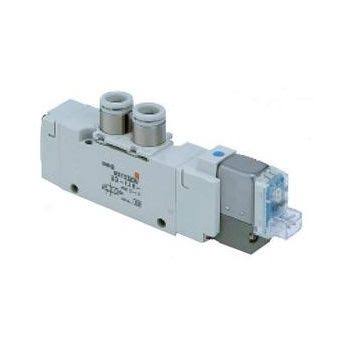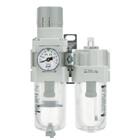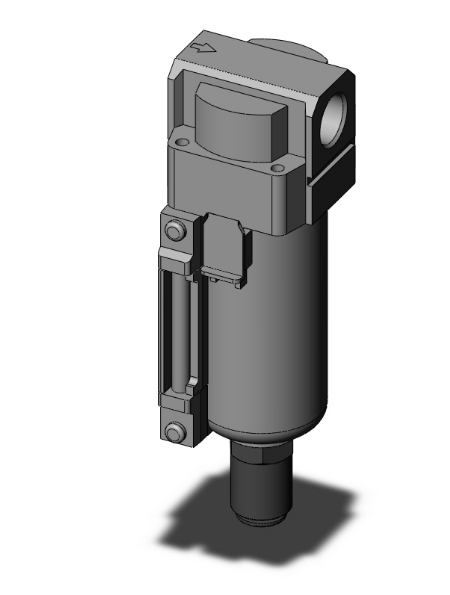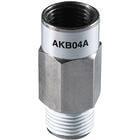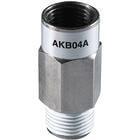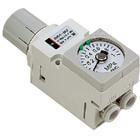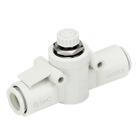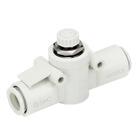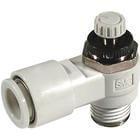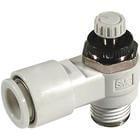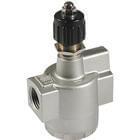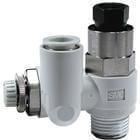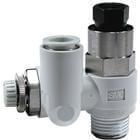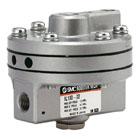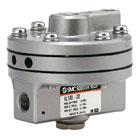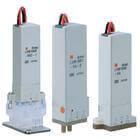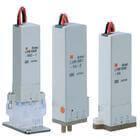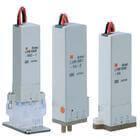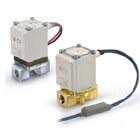SMC Fluid control equipment
IN STOCK!!!
Pneumatic regulator
- Body Size: 40
- Port: 04 (1/2)
- Option: Standard
IN STOCK!!!
VQZ200 Valve, SOL 3-PORT
- AC10A-40A-A (FRL)
- Modular Type
- Filter Regulator + Lubricator
- AC10A-60A (WL)
- Modular Type
- Filter Regulator
- Lubricator
- AC10A-40A-A (FRL)
- Modular Type
- Filter Regulator + Lubricator
Series AFM modular style mist separator
- AKB
- Check Valve with One-touch Fitting
- Push Type
- AKB
- Check Valve with One-touch Fitting
- Push Type
- AKB
- Check Valve with One-touch Fitting
- Push Type
- ARM10
- Small Manifold Regulator
- Single Unit
- ARM10
- Small Manifold Regulator
- Single Unit
- AS1002F/4002F
- Speed Controller
- One-touch Fitting
- In-line
- Compact
- AS1002F/4002F
- Speed Controller
- One-touch Fitting
- In-line
- Compact
- AS1002F/4002F
- Speed Controller
- One-touch Fitting
- In-line
- Compact
- AS***1F
- Speed Controller
- One-touch Fitting
- Elbow & Universal Types
- AS***1F
- Speed Controller
- One-touch Fitting
- Elbow & Universal Types
| Port size | 1/2 |
| Flow rate (/min (ANR) | 6,600 |
| Effective area | 100 mm2 |
- ASP
- Speed Controller with Pilot Check Valve
- ASP
- Speed Controller with Pilot Check Valve
- ASP
- Speed Controller with Pilot Check Valve
- ASV
- Speed Exhaust Controller
- ASV
- Speed Exhaust Controller
- ASV
- Speed Exhaust Controller
Actuator
- EIL100
- Booster Relay
- European
- IL100
- Booster Relay
- Metric
- LVM10/100
- 2/3 Port Solenoid Valve for Chemicals
- LVM10/100
- 2/3 Port Solenoid Valve for Chemicals
- LVM10/100
- 2/3 Port Solenoid Valve for Chemicals
- VX2**
- Direct Operated 2 Port Solenoid Valve for Medium Vacuum/Water/Oil/Steam. (New Product)
Overview of SMC Fluid Control Products
SMC offers a wide range of fluid control equipment. Let's take a closer look at the positions offered.
Speed controller with indicator/Inline type AS-FS
- Numerical display of flow regulator speed reduces flow set-up time and set-up errors.
- The flow rate can be controlled numerically using the indicator window.
- 4 directions of the indicator window are available.
- Larger latch handle
- Improved flow rate reproducibility
- Nile coating without electrolysis is standard
Two-speed ASD controller
- Possibility of bi-directional flow control with speed controller (inlet and outlet counter).
- Prevents cylinder wobble.
- Single-acting cylinder speed control.
ASP piloted check valve speed controller
- Built-in pilot check valve and speed controller.
- Realizes instant intermediate stop of the cylinder and can adjust its speed.
- Pneumo-electric reducer SMC series VR3200/VR3201
- Designed to control the presence of pressure in the pneumatic system.
- Used in electro-pneumatic control systems.
ISG general-purpose pressure switch
- Designed to control the pressure of the working fluid or compressed air.
- Adjustable hysteresis.
- The high degree of performance reproducibility.
- Applicable with a wide range of working media: compressed air, vacuum, water, steam up to 150 °C (stainless steel version), inert gases, mineral oils, as well as any liquid that does not cause corrosion of stainless steel.
Pressure switch IS10
- It is used to control the pressure of compressed air.
- Setting pressure 0.1-0.4 MPa or 0.1-0.6 MPa.
- Resource 5 million cycles.
- Suitable for modular installation.
- Various mounting options:
- at the outlet of the compressed air preparation unit
- between compressed air preparation devices
- offline installation
Pressure switch IS3000
- Designed to control the pressure of compressed air.
- Can be used for small loads of 10 mA, with devices such as relays, programmable controllers, etc.
- Can work with high frequency - 1 cycle per second.
- Long service life (more than 10 million cycles) due to the piston design.
- Easy pressure setting with pressure scale.
- Wide pressure setting range: 0.1 - 0.7 MPa.
Airflow sensor PF2A5
- Designed to control the level of airflow in the pneumatic system.
- Easy to use and set up.
- Remote controller.
- Measures instant and accumulated expenses.
- Two digital outputs (PNP/NPN, using PF2A300 controller).
- Analog output (1 - 5 V or 4 - 20 mA).
- Reconfigurable on-off modes of the output signal.
- Degree of protection IP65.
Miniature flow sensor PFMV
- Designed to control the level of compressed air or nitrogen consumption.
- Non-linear analog output 1 - 5 V.
- Suction control for very small objects.
- Remote controller PFMV3.
- Minimum installation space.
- Compact (34.4x10x18 mm), weight 10 g.
- Response time less than 5 ms (for comparison: PFM7 / PFM5 - 50 ms).
- Reproducibility ±2%.
- Various mounting positions and installation methods.
SMC provides many more different positions in the fluid control equipment line. You can check the full list of products on the Eltra Trade website. Our managers are always happy to advise you on all your questions and help you choose the right equipment for you.
Applications of SMC Fluid Control Equipment
Here are the main applications of SMC fluid control equipment.
Compressed air
Solenoid valves for unloading the compressor at start-up.
Condensate drain valves.
Agriculture
Dosing fertilizer with motorized valves.
Hot water and steam valves.
Water ball valves.
Irrigation pressure relief valve.
Central heating
Solenoid valves for HVAC-R systems.
Radiant warm floor.
Solar heaters for swimming pools.
Car wash
Solenoid valve used for the car wash.
pressure washer gauge.
Pressure washer valves.
Brewery
Valves for brewing equipment.
Pure water
Valves for reverse osmosis systems.
Valves, pipes, and hoses for drinking water.
Ball valves for drinking water.
Water check valves.
Hose applications
Milk hoses.
Steam hoses.
Pressure and suction hoses.
Air and gas hoses.
Benefits of Using SMC Fluid Control Equipment
A distinctive feature of fluid control equipment is its reduced power consumption. In particular, depending on the type of device, the manufacturer can use chips to optimize this aspect.
- Strengthening the flow.
- Streamlined shape.
- Materials that contribute to better conductivity of electric current.
Being embodied one by one or in combination, all these techniques can significantly reduce your energy bills in comparison with the use of equipment from other arbitrators. It also has a positive effect on the environment by reducing the heating of devices of non-renewable resources such as electricity helps industrial companies reduce their negative impact on the greenhouse effect.
Maintenance and Care Tips for SMC Fluid Control Equipment
Here are some tips on maintenance and care of the SMC fluid control valve and other fluid control equipment.
- Failure to follow proper procedures may result in product malfunction and equipment or machine damage.
- Compressed air can be dangerous if mishandled. Assembly, handling, and repair must only be carried out by qualified personnel.
- Shutdown before maintenance: before starting any kind of maintenance, make sure that the supply pressure is turned off and the residual air pressure is released from the system to be worked on.
- Start-up after maintenance: apply operating pressure and power to the equipment and check for correct operation and possible air leaks. If the operation is abnormal, check the product settings.
- Do not make any changes to the product.
- Do not disassemble the product unless required by installation or maintenance instructions.
SMC products are lubricated for life by the manufacturer and do not require lubrication during operation. If the system is lubricated, use Class 1 turbine oil (no additives), ISO VG32. Once the lubricant is used in the system, lubrication must be continued as the original lubricant applied during production will be washed away.
Maintenance must be carried out in accordance with the procedures outlined in the instruction manual. If handled incorrectly, it may cause damage or malfunction of equipment, devices, etc.
